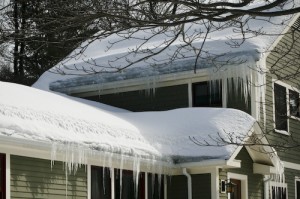 We’ve just been slammed by ANOTHER Blizzard here in New England, and it’s left quite a mess. With more snow in the forecast we seriously need to consider how to get snow off the roof safely and avoid the risk of a roof collapse and ice damming.
We’ve just been slammed by ANOTHER Blizzard here in New England, and it’s left quite a mess. With more snow in the forecast we seriously need to consider how to get snow off the roof safely and avoid the risk of a roof collapse and ice damming.
To help we’re sharing these tips for homeowners removing snow and ice from roofs. These tips we’re provided by the Massachusetts Department of Public Safety & Department of Fire Services
TIPS FOR ROOF SNOW REMOVAL
Use a snow rake for pitched roofs (available at most hardware stores) to remove snow from your roof.
Start from the edge and work your way into the roof.
Try to shave the snow down to a 2 or 3 inches on the roof instead of scraping the roof clean, which will risk damage to your shingles or other roof covering.
Keep in mind that any metal tool could conduct electricity if it touches a power line and metal tools may cause damage to the roof.
Shovel snow from flat roofs throwing the snow over the side away from the building. Most plastic shovels are better, except for the ones with curved blades-those too will do some damage to your roof.
Remove large icicles carefully if they’re hanging over doorways and walkways. Consider knocking down icicles through windows using a broom stick.
Wear protective headgear and goggles when performing any of these tasks.
Consider hiring professionals to do the job. The combination of heights plus ice makes this one of the more dangerous house chores.
If you don’t hire professionals, at least have someone outside with you in case anything does go wrong.
Keep gutters, and drains clean, free of ice and snow and keep downspouts clean at ground level.
DON’T DO THIS WHEN REMOVING SNOW FROM ROOF
Unless approved by a registered professional engineer, don’t add your weight or the weight of equipment to the roof.
Don’t use a ladder since ice tends to build up on both the rungs of the ladder and the soles of your boots.
Don’t use electric heating devices like hair dryers or heat guns to remove snow and ice.
Don’t use open-flame devices to remove snow and ice.
A cubic foot of dry snow weighs about seven pounds, while a cubic foot of wet snow may weigh up to 20 pounds; that’s heavy. So, if possible, building owners should consider hiring someone to help with all of the snow clearing.
HOW TO RECOGNIZE PROBLEMS WITH THE ROOF
Sagging roofs
Severe roof leaks
Cracked or split wood members
Bends or ripples in supports
Cracks in walls or masonry
Sheared off screws from steel frames
Sprinkler heads that have dropped down below ceiling tiles
Doors that pop open
Doors or windows that are difficult to open
Bowed utility pipes or conduit attached at ceiling
Creaking, cracking or popping sounds
ADDITIONAL SAFETY TIPS
Make sure your smoke alarms and carbon monoxide detectors are working.
Check your outside fuel (furnace) and dryer exhaust vents, making sure that they are not obstructed by snow or ice.
Never use cooking equipment intended for outside use indoors as a heat source or cooking device. Never use your oven for heat. Clear snow away from furnace and dryer exhaust vents to prevent carbon monoxide poisoning.
Space heaters need space, so use them in a 3-foot circle of safety; free of anything that catch fire. Space heaters are not designed to replace your central heating system; they are only designed to provide a little extra heat on a temporary basis. So be sure to turn them off when you leave room or go to bed at night.
Clear snow away from downspouts so water has a place to go.
Do not be tempted to use a heat gun or open flame torch to melt the ice; the risk of starting a fire is huge.
If you feel you are in immediate danger, get outside and call 9-1-1.

